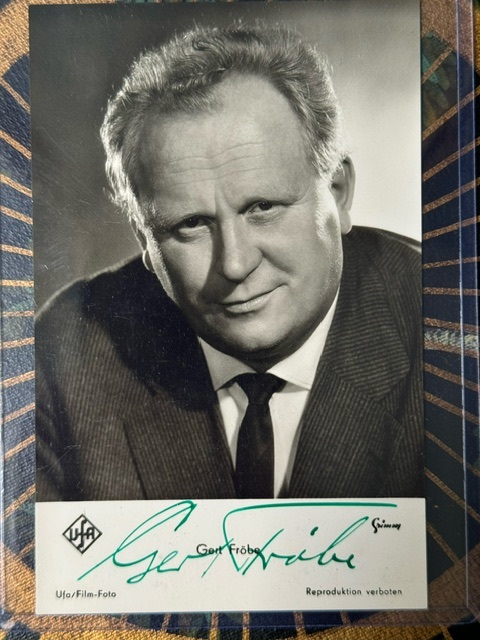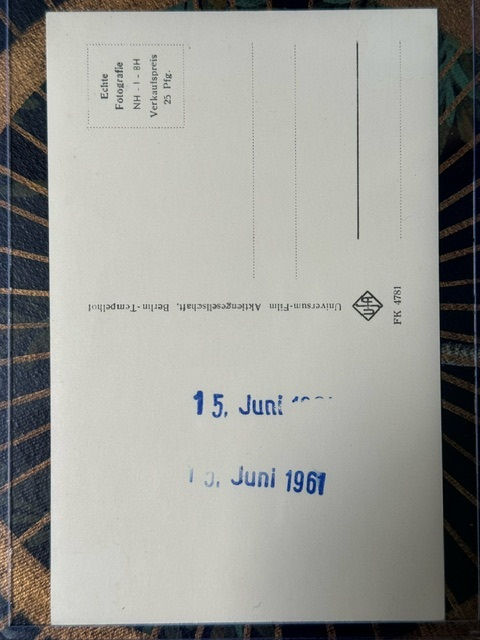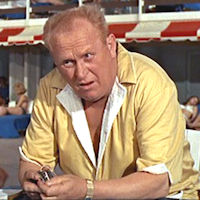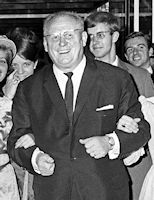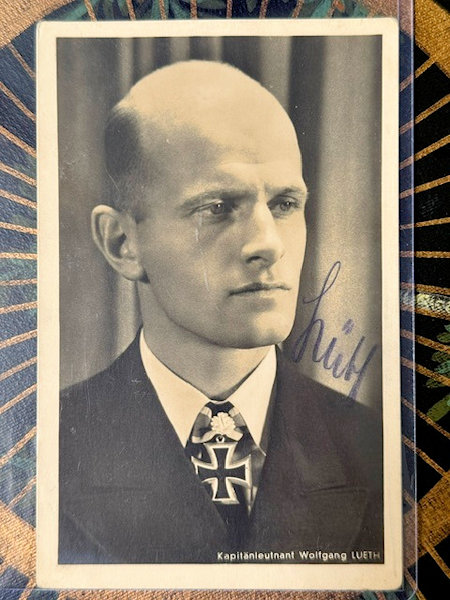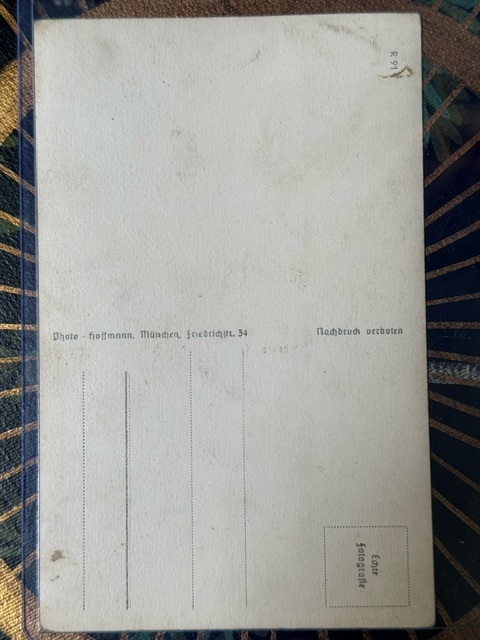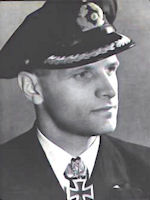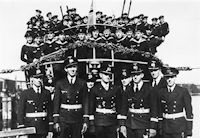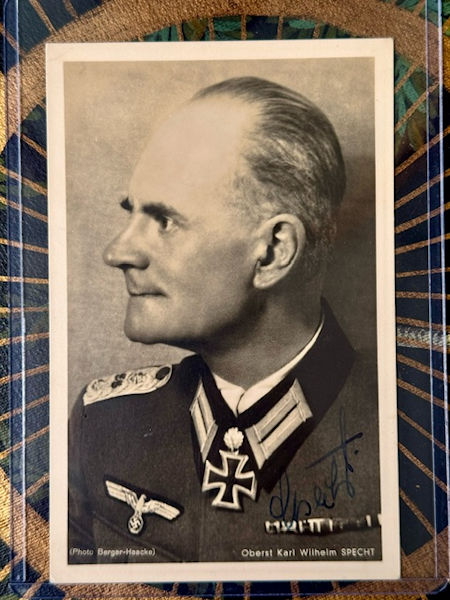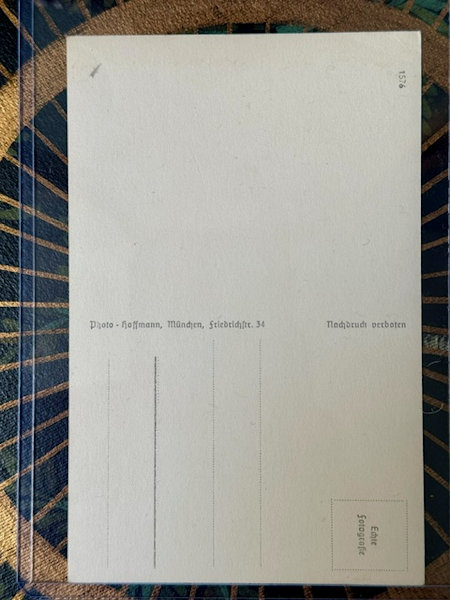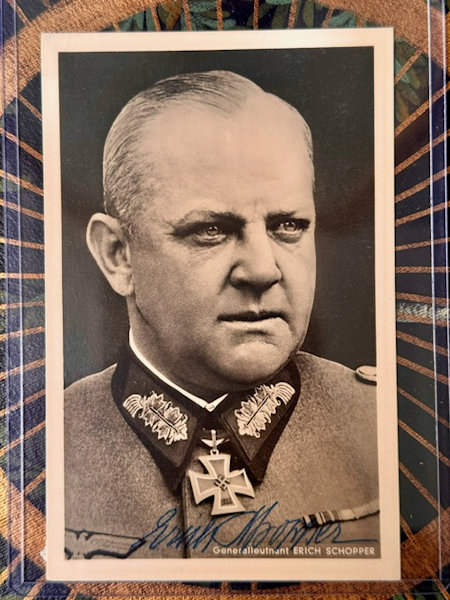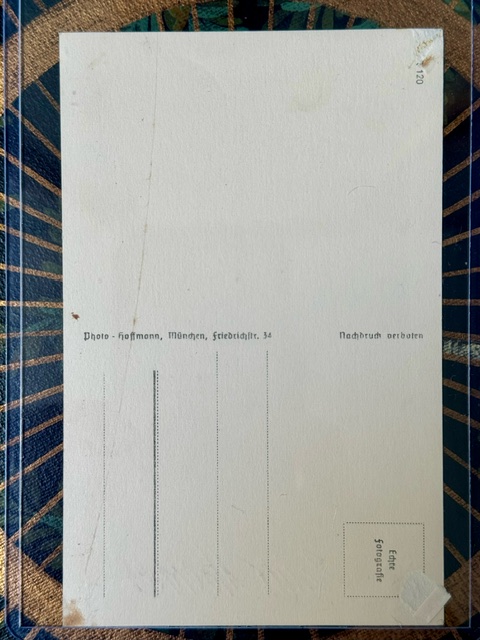|
|
|
|
Personality Items
Page 7
|
|||||||||||
|
The Book of Love signed by Heinrich Himmler (Item PERS 7-1; HH 4-18; SS 38-3) |
|||||||||||
| DESCRIPTION: The book is by Werner Jansen and is titled Das Buch Liebe published by Georg Westermann in Braunschweig with copyright date of 1920. It comprises 304 pages. The cover is in green cloth with gilt title on the spine, and a small tear on the edge of the spine (fixable!); otherwise, fine. This is a presentation to Heinrich Himmler, inscribed to him on the front flyleaf with: �Oberwachtf�hrer of the Rote Kreuz (Red Cross) Ilse Doehring with friendly greetings November 1940.� Beneath this Himmler has added his ownership signature: �H. Himmler.� This epic saga was dedicated to young women whose men were at the front during WWI. The author, Werner Jensen, and this work were very dear to Himmler�s heart in 1924. After first reading it Himmler declared this book, �. . . the songs of songs to the Nordic woman.� He said, �This is the ideal image we Germans dream of in our youth and are ready to die for as men.� (�Very good� and historically important to the extreme.) It shows the obvious sentimentality of the Reichsf�hrer-SS. This is not only revealing, but Himmler's signature is one of the boldest and best of his that we have ever seen. He was obviously proud to own this book.
PRICE: SOLD |
|
|
|
|
|
Two Landsknecht Tapestries from the Home of Dietrich Eckart, Connoisseur of the Arts (Item PERS 7-2; LAND 2-4; ART 18-5) |
|
DESCRIPTION: These two fantastic hand-woven tapestries once graced the walls of the Berchtesgaden Bavarian home of the man that Adolf Hitler called his mentor; this was Dietrich Eckart (1868-1923). Eckart began his career as a journalist and poet. He blamed his earlier lack of success on the Jews and Marxists. He also blamed the socialists for Germany�s defeat in WWI and in 1918, entered politics and created one of his several poems�the battle cry �Deutschland Erwache!� (�Germany Awake!�). Eckart was an early member of the German Workers� Party that evolved into the National Socialist Workers� Party (Nazi Party). He began a close friendship with Adolf Hitler and introduced the awkward, young politician to the �right� people in Munich. He also encouraged Hitler in his political agendas and nationalist aspirations. Eckart�s �Storm Song� was the oldest national hymn of the N.S. Party. In a pamphlet published shortly before his death, Eckart hailed Hitler as the man who would reveal the whole conspiracy of the left. (He often said that Moses was the first Bolshevist.) Eckart was in essence the father of the N.S. Party and for a time he did �awaken� the Germans�they listened to him; at least in Munich, Haupstadt der Bewegung,� (Capital of the Movement) and after Hitler had made his mark, that city and all of Germany listened to Eckart�s prot�g�. Information passed to us from German historian sources lead us to believe that Herr Eckart was a lover of the arts. We do know that he was independently wealthy and enjoyed the art and music of the Germanic peoples throughout the ages. He loved and strongly identified with Henrik Ibsen�s Peer Gynt. His father was a royal notary and law counselor in Nuremberg and was independently wealthy. The father was a collector of the finest in objects d�art. Dietrich became a playwright in Berlin under the tutelage of Georg Graf von H�lsen�Haeseler. During this time Dietrich developed an ideology of what has to be termed �genius� (higher human strata) at one point based on earlier writings by Lanz von Liebenfes. He joined the Thule Society in 1913 and became politically active in 1915. He wrote the nationalist play �Heinrich der Hohenstauffe� (�Heinrich of the High Baptism�) in which he postulated a claim to world leadership for the German people. Much more about this man of destiny can be Googled, but please read between the lines. Political correctness does have a way with defamation. This was the man to whom Hitler dedicated the first volume of Mein Kampf. During all of this fantastic and colorful career he was known to have strong interests in the collecting of Germanic art, a favorite subject in which he indulged himself. There were various art objects that depicted German warriors: from the fighting men like Arminius the Liberator (commonly called �Hermann�) who defeated Roman legions in the Battle of the Teutoberg Forest in the year 9 A.D., to Frederick Barbarossa�s knights. But, especially, he adored the stories of the Germanic Landsknechte, the colorful mercenary soldiers who had a formidable reputation and were to become an important professional warlike force through the late fifteenth and sixteenth centuries. They consisted predominantly of German mercenary pikemen and supporting foot soldiers and they achieved the reputation for being the best universal soldiers for hire in early modern Europe. Landsknechte typically came from Swabia, Alsace, Tyrol, and the Rhineland. These two magnificent tapestries depicting typical German Landsknecht soldiers were taken from the villa of Dietrich Eckart in Berchtesgaden by an agent enlisted by the OSS, which eventually became the CIA. Locals in that picturesque Bavarian community tell us that this particular house is still in use by the CIA. We cannot offer any educated backup knowledge of this, but that is the rumor. This has been an incredible journey indeed and our information was supplied by the son of the now-deceased operative. We did not receive the tapestries from this man, but after we bought them from an antique dealer, we showed them in a private antique show. The son of this OSS official saw them and immediately approached us and identified the pieces as the very ones that his father had in his possession and later sold. The older gentleman had not even known at first that this was the house of Hitler�s mentor until he was filled in by senior staff officers who had such knowledge. There is no doubt whatever as to the location of the house, and it is well known to historians; I have seen it myself as have other military historians. It is still there: a very nice little Landhaus from which came these magnificent Landsknectsoldaten tapestries. The Tapestries The tapestries are rather large, and measured from inside the frame they are 5 feet x 2 1/2 feet. The frames are 1 � inches wide and are what we would call �OK!� These magnificent European art objects deserve more elaborate framing and I am sure when the right collector or institution acquires them this might well be accomplished. When they were �liberated,� we believe they were in elegant frames, or so we are told, but because of the nature of the moment of �acquisition� the frames had to remain behind at the villa. As you can obviously see, the tapestries are still showing the incredible artwork used in their wonderful production and were, of course, hand produced using the weaving art form known as petit point, the finest woven art the world has ever seen. The normal way that human figures were done was by needle point. To accomplish anything like these two tapestries in petit-point weaving would be infinitely more difficult and in subjects as large as these would be a labor so arduous so as it would seem absolutely impossible. Certainly it could not and would not be accomplished today. We ask that you would just imagine the length of time, the considerable amount of years it would take to weave these two tapestries all by hand. If there would be a glimmer of doubt that this was entirely (Handarbeit) �handwork� one can look at the back and see where even the smallest detail is separately tied off by hand and again this is incredible petit point. The work is many times more tedious to do than needlepoint. Even If it had been the larger weave it still would have been worthy of museum display. Petit-point works are so extremely rare�especially when of antiquity. Most are in museums and in many cases they are considered national treasures. I believe these could and should fall into that category. It is certain that Herr Eckart did! The soldiers are just as elaborately ornamental as you could possibly imagine. They have a unique three-dimensional effect. The embellishments are ornately superb and the artist was very knowledgeable of the Landsknecht costuming, weaponry, and historical presence. No European museum curator could possibly portray these tough mercenary fighters better. The soldier on the right holds a pike that was the initial weapon of these cadres (pikemen). He also has the great two-handed sword that has come to be known worldwide as the Landsknecht sword, �Zweih�nder.� He also wears the short sword known as the Katzbalger. Beside him is seen a shield that depicts a mountain flower. Actually this same flower is seen in over 70 depictions in the background of the tapestries each one hand woven individually into the entire scheme. The figure on the left has a rapier (heavy sword), and he wears in his belt the Swiss-style mercenary dagger that is what the Nazi SA dagger was modeled after in the Third Reich. Beside him you can see a shield bearing two rampant lions. Both men are dressed in extremely exuberant costumes as Landsknechts always wore. It was the historical signature of the mercenary profession in that turbulent time. It seemed to be the rule that if a soldier was very handsomely attired, the more he had a genuine appeal to those who sought to hire him. We must note that these artworks are very handsome to an exceedingly intense degree and surely are without a doubt two distinct treasures of the Western world. Now comes the rather disappointing part. After these two tapestries were framed and set to be featured in a high-art auction, there came a time that they were sadly set in a place in the auction house where they shouldn�t have been. This was inexcusable and one tapestry was actually lying on top of the other and then tragedy struck! There was a large paper tarp placed over them to keep them clean and their being in that location was to be very temporary, but in the hectic goings-on there on that day, along came a stock attendant and seeing the white paper he thought it to be a table top and he placed an extremely heavy object right on top and needless to say this object plunged right through the precious tapestries like a knife through butter�tragic? Most certainly! Did they lose all value? NO! They still are what they are. Did they lose very significant value? YES! The reserve price of these fantastic items was simply astounding. The insurance settlement was even more than astounding. Later, we were offered them and after seeing them we just had to have them. Why? Because of all we have said about them in this essay we still truly feel they are extremely important historical items and possess sheer beauty and to us the fact that they were owned by one of German history�s most important and possibly most infamous individuals does give them some significant additional prestige. However, they do stand on their own as what I can only describe as masterpieces of the weaver�s art. The damage is very noticeable when looking at them close up and a more professional repair could make them fairly whole again, but it would necessitate finding an artist who would be able to duplicate the Old World skills and frankly we do not think anyone today would be in the least capable of this. (*Our opinion). The damage is as follows: the tapestry on the right in our pictures has a gash from the bottom of the pike�s point and blade down to the hat of the man�s head and down along the outside area along the man�s face, but incredibly missing the face�thank goodness! It continues for a short distance along the sleeve of the costume. The gash on the figure on the left begins at the top of the banner and travels down through the ensign and then proceeds both right and left and then surrounds the large white hat plume and the Landsknecht hat and down to the pom-pom decoration in the center of the standard. After tracing along on the hat plume it travels about nine inches into the background and by some miracle it also missed the face. The repair that was attempted looks rather crude, but when one looks at the figures straight on, the repairs are not quickly noticeable. They are still of such a quality that any trained eye that will appreciate such excellence might just forgive their past misfortune. It is beyond incredible that the faces were missed in the horrid accident. Remember Venus de Milo is missing her arms and Nefertiti lost an eye, but they are still loved and adored. These tapestries will without a doubt end up being a prized display in a museum, someday. In the meantime, we enjoy the privilege of stewardship. Congratulations Dietrich Eckart for having owned them. Deutschland Erwache! PRICE: Price on request: Serious inquiries only, please |
|
|
|
|
|
Pair of Krupp Berndorf Dessert Bowls from the Home of Martin Bormann in the Obersalzberg (Item PERS 7-3) |
| DESCRIPTION: The small bowls were �liberated� by GI�s and were part of a grouping gathered together and sold at auction several years ago. Bormann had the national political eagle on practically all of his tableware, glassware, etc. In this case, we see the proverbial handsome N.S. eagle beautifully stamped in the bottom of these Krupp bowls. Bormann ordered them from the famed Krupp Berndorf factory with the �special feature� noted. They measure about 2 1/4 inches deep with a mouth opening of 5 inches. They are made of extra-high-quality silver plate (alpacca) and you can see here the Krupp marks as used in the National Socialist era. The items were probably used as some type of dessert bowls in either the reception studio or in the private study for complimentary nut or candy treats for guests. It has been said that Martin Bormann was a very gracious host and we know he was the absolute most able administrator of the party. He was known as the �Brown Eminence� in his role as the head of the party chancellery. He was also the private secretary to Adolf Hitler and certainly, we know that he had significant influence in major decisions when advising the F�hrer.
PRICE: $1,450.00; a great bargain! |
|
||
|
Krupp Centenary Medal in Silver (Item PERS 7-4, KMEDAL 4-26; ART 14-14) |
||
| DESCRIPTION: This is a rare medal that celebrates 100 years of the Krupp dynasty from Alfred Krupp who was born in 1812 and died in 1887. He was known as the cannon king, or as �Alfred the Great,� from the time of Fredrich Krupp, 1787-1876. The family launched a small steel factory in Essen in 1811 to go on to become the greatest producer of weapons and ammunition the world has ever known. The medal struck in fine silver is oval in shape and is marked on the edge �990,� the closest to �1000� in pure silver that a medal could be. It has a good depiction of Alfred Krupp on the obverse, while on the reverse is the depiction of a muscular blacksmith with hammer, anvil, and a sword that he has forged. At the edges it says �1812 Alfred Krupp 1912. The ribbon is in the colors of the city of Essen. This large medal was presented during the centenary celebrations to Krupp�s leading customers plus important military and civil leaders. They are rare today as very few were struck and those that survive are in museum collections today. The medal measures 2 1/2 inches high.
PRICE: $450.00 |
|
|
|
|
|
|
| DESCRIPTION: Here is possibly the rarest and most important ring we have ever had. It is the double-link ring that features the side-by-side links that are reminiscent of the style used in the chain links of the SS dagger suspension of a 1936 chained SS dagger as designed by Professor Karl Diebitsch. This amazingly talented artist extraordinaire was the original designer of the black SS uniform, various postage stamps, many SS crests, great paintings, SS swords, wonderful tapestries, and many other SS-oriented items. Diebitsch carried the rank of SS-Oberf�hrer. He served during the war years in the SS-Totenkopf division, SS-Germania, and SS-Wiking. He was promoted to SS-Oberf�hrer 20 April 1944 (Hitler�s birthday). The fact that he designed this ring is pretty much assured. The Amazing Find Reinhard Heydrich was the chief of the Reich Main Security office Sicherheitsdienst (SD) which included the Gestapo and the ripo and he served as president of the international police organization known as Interpol. He was the ultimate policeman!--the Antifa maggots would especially despise him! On 27 September 1941, Heydrich was appointed deputy Reichsprotector of Bohemia and Moravia. He is often called �Heinrich the Butcher� by the yellow journalists and others, but a text closer to the truthful saga of this remarkable man can be seen at the revisionist blog �Inconvenient History." When Reinhard lived in the castle estate in Panensk� Bre�any, the neighbors considered him and his family to be model citizens regardless of the fact that they were not Czechs. The Ring After the foul murder of Reinhard Heydrich, the upper Panensk� continued to be the home of Lina Heydrich, his beloved widow. Up until the end of WWII, the castle became state property after the hostilities ended, then it was taken over by the Communist government. As of 1957, it was used as a home for the elderly. Reinhard would have approved of this, in our opinion. This is what we have been told. The castle was left vacant long after the war, but somewhere along the line the castle was sealed for a time. Then a hired worker was looking about in the lower castle with the idea that he might be involved in any restorations that might be instigated by the Czech government. During his close inspection of the apartments therein, he opened doors that had been shut for decades. All the furniture, paintings, tapestries, had been looted and the rooms were devoid of any items of the slightest value�totally looted! When this worker nudged open the door to a dilapidated bedroom, the door�s hinges emitted an eerie, squeaking noise having rusted because of leaking water from the bathroom above. For years, and for whatever reason, this door was not opened during any of the looting expeditions until now in this exploratory inspection. When the door was freed up from the hinges and opened, to this worker�s surprise there in plain sight was this magnificent ring which he immediately pocketed. The rest of the story is now revealed and it goes like this: The man known to us only by his first name Stanislaus kept the ring for many years and left it to his grandson after his passing. The grandson sold it to an antique dealer in Prague, who in turn sold it to a collector of antiques who, recognizing its historical value, sold it to another collector and finally it came to the U.S. The ring probably was the template for another ring that was made in silver. We have had one of these silver rings in the past and they are quite rare, but this one is beyond rare, and entirely unique! The obvious difference is that the shank or band�the part that circles the finger�is in genuine gold, while the center design (the links) seem to be hand set within the gold framing, and this part is in silver with a pebbled background effect. On the band are wreathed swastikas that are individually jewelry set, in a very ultraprofessional procedure. In all our long years in this field, we have never seen such excellence in jewelry workmanship. The wearing size of the ring is 11 �, a good size for a tall no-nonsense, brave fighting man like Oberf�hrer Heydrich. It is historically noted that when the cowardly British-paid assassins fatally wounded him, he managed to get out of the car and chase them for nearly two city blocks holding and possibly firing a Luger pistol. It�s no wonder that Hitler referred to him as the Man with the Iron Heart. PRICE: SOLD |
|
|
|
|
Karl Gerhart "Gert" Fr�be Autographed Photograph (Item PERS 7-9) |
| DESCRIPTION: "Gert" Fr�be (1913-1988) was a German stage and film actor, who is famous for playing Auric Goldfinger in the James Bond film Goldfinger. He was born in Oberplanitz, today part of Zwickau. He was initially a violinist, but he abandoned it for Kabarett and theatre work. He joined the Nazi Party in 1929 at the age of 16 and left in 1937, before the outbreak of the Second World War. In September 1944, theatres in Germany were closed down and Fr�be was drafted into the German Army, where he served until the end of the war. After his party membership became known after the war, Israel banned Fr�be's films until Mario Blumenau, a Jewish survivor, revealed just eight weeks later that his life and his mother's were probably saved when Fr�be hid them from the Nazis in his basement. This is a beautiful black-and-white photo postcard signed by him in 1961. Size is 3 1/2 x 5 1/2 inches and is in excellent condition.
PRICE: $175.00* |
|
|
|
Wolfgang L�th Autographed Photograph (Item PERS 7-10) |
| DESCRIPTION: Wolfgang L�th is second most successful German U-boat ace credited with 46 victories. He was accidentally shot and killed by a German sentry. L�th was given the last state funeral of the Third Reich, the only U-boat commander to be so honored. This is an excellent and rare war-date S.P., 3� inches x 5� inches b/w, a chest, up pose by Hoffmann signed adding his rank: "Korvettenkapit�n Kommandant seiner U-boat." Fine condition.
PRICE: $800.00* |
|
|
Karl-Wilhelm Specht Autograph Postcard (Item PERS 7-11) |
| DESCRIPTION: Karl-Wilhelm Specht (22 May 1894�3 December 1953) was a Wehrmacht infantry general and a recipient of the Knight's Cross with Oak Leaves. He served on the "Court of Military Honor," which tried officers suspected of involvement in the July 20, 1944, assassination plot against Hitler. S.P., 3 1/2 x 5 1/2 inches, a Hoffman photo postcard bearing a chest-up profile view of Specht in uniform with his Knight's Cross at his throat. This is in fine condition.
PRICE: $250.00* |
|
|
Erich Schopper Autograph Postcard (Item PERS 7-12) |
| DESCRIPTION: Erich Schopper (2 July 1892�18 August 1978) was a German general in the Wehrmacht during World War II and commander of the 81. Infanterie-Division, and a recipient of the Knight's Cross. Hoffmann postcard signed postcard 3.5 x 5.5 in. b/w, boldly signed in blue ink. Fine Condition.
PRICE: $200.00* |
|
||||||||
|
Extraordinary Collection of 20 Signatures of High-Ranking National Socialist Personalities (Item PERS 7-13; AHSIG 3-9) |
||||||||
| DESCRIPTION: We are very proud to offer this unique set of signatures that was collected by a Hitler Youth boy during his visit to the Reich Chancellery. The signatures of these 20 high-level National Socialist dignitaries appear on the personal Reich Chancellery stationary of Adolf Hitler. The young man was probably related to someone who was able to introduce him to these leaders of the Reich. Many of the signatures were obtained at an event at the Chancellery in 1935, while some were obtained afterwards. The Hitler Youth boy was proud enough that he had them framed with his photograph to recount those special times of meeting these unique leaders of the Third Reich. The signatures are as follows: Adolf Hitler Hermann G�ring Joseph Goebbels Heinrich Himmler Martin Bormann Joseph �Sepp� Dietrich Julius Schreck Julius Streicher Robert Ley Rudolf Hess Max Amann Ernst �Fritz� Sauckel Wilhem Keitel Reinhard Heydrich Kurt �Panzer� Meyer Karl Wolff Heinz Harmel Otto Kumm Philipp Bouhler August Eigruber This extremely rare collection of signatures is framed, so the condition is pristine. Here are truly rare pieces of history thanks to a young boy who was proud of his nation and its leaders. PRICE: $10,000.00x |
|
||||
|
Signature and Images of �Sepp� Dietrich (Item PERS 7-14) |
||||
| DESCRIPTION: This nice, original �Sepp� Dietrich signature comes framed with two original photos of the subject. Josef �Sepp� Dietrich joined the Nazi Party in 1928. He was a sergeant during WW I. Later, he became Adolf Hitler�s chauffer and bodyguard and later, commanded Hitler�s SS bodyguard unit and, later, was elected to the Reichstag as a party deputy. In 1931, he was promoted to SS-Gruppenf�hrer and in 1933, Hermann G�ring appointed him to the Prussian State Council; Dietrich then fleeted up to commander of the SS Special Command unit. Afterwards, he was appointed to command the LSSAH Waffen-SS Leibstandarte Division and received orders from Hitler to form an execution squad whose mission was to execute Ernst R�hm, among others. Dietrich was then promoted the SS-Obergruppenf�hrer and lead the SS-Leibstandarte all through Europe, Greece, and Russia during WW II. He received the Knight�s Cross with oak leaves, swords, and diamonds.
PRICE: $400.00x |
|
||
|
Photograph Signed by Hitler (Item PERS 7-15; AHSIG 3-10) |
||
| DESCRIPTION: This is an original Hitler signature on a photo of his reviewing troops of the Kriegsmarine, dated February 13, 1939. The signature is clear and succinct and the overall quality is excellent. Authenticity is not questioned; it carries a COA from one of the most respected autograph specialists, Terry Patton of Patton Militaria, Atlanta, Georgia. He's a member of the UACC, registered dealer #RD028.
PRICE: SOLD |
Page Seven |
Page Six A Very Special Entry! One of the greatest historical treasures we have ever had the pleasure of offering. You have to see this one! CLICK HERE! |
Please refer to item designator in parentheses in all correspondence.
If you prefer, contact 'Germania' at PO Box 68, Lakemont, GA 30552
or call at 706.782.1668 or 706.782.4398.
Please! do not call during the wee hours of the morning. The best time for calling us is between 10 and 11 am and between 9 and 11 pm eastern time.


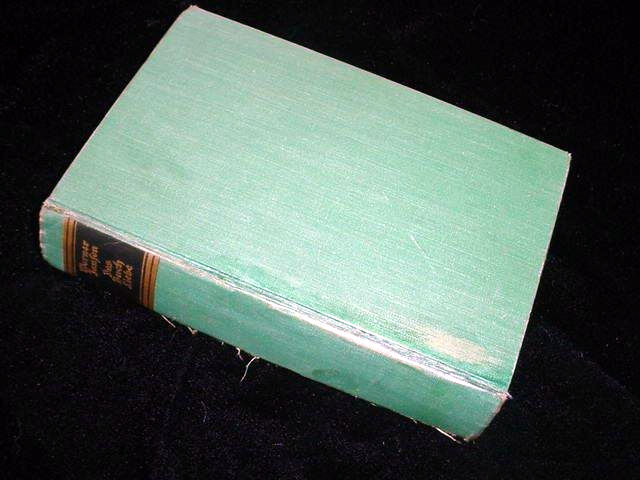
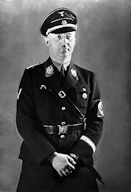
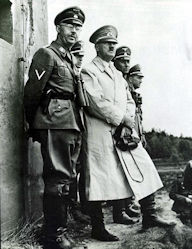
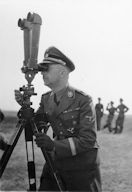
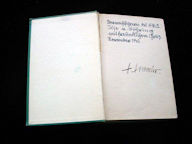
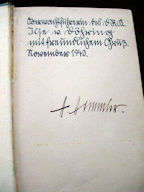
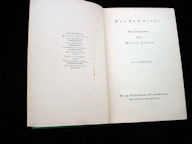
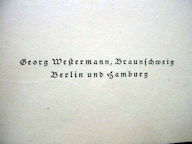
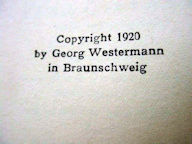
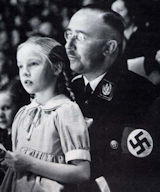
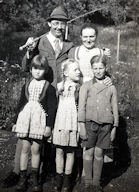
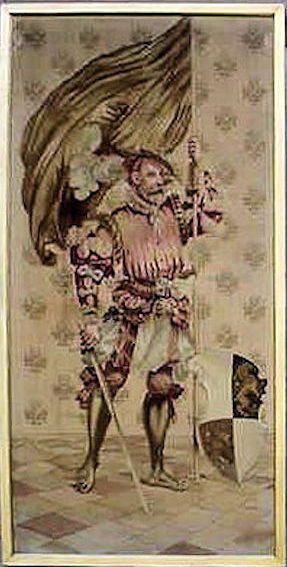
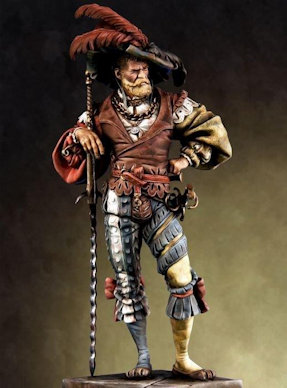
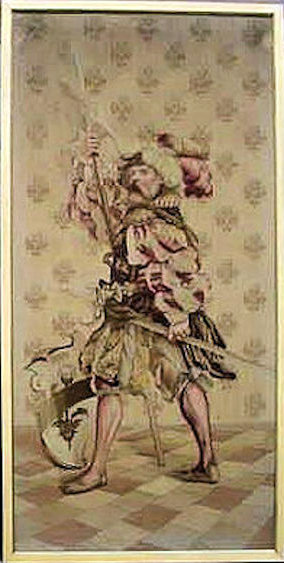
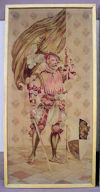

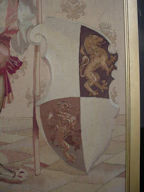
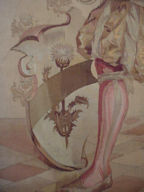
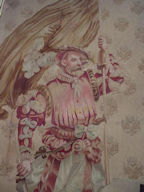
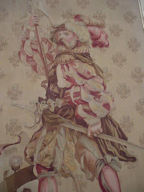
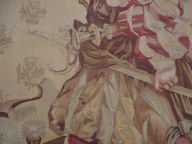
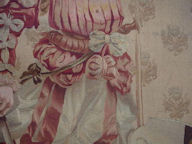
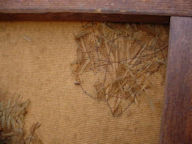
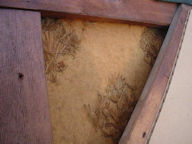
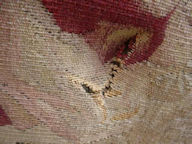
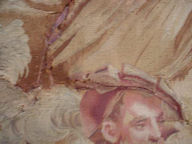
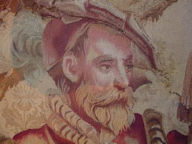
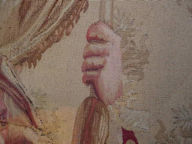
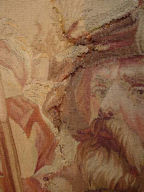
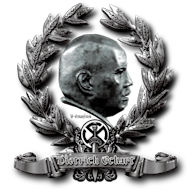

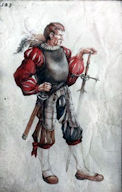
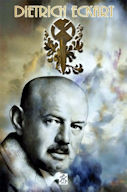
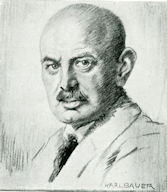
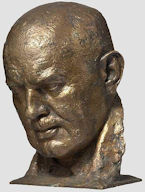
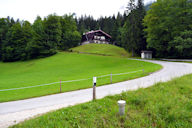
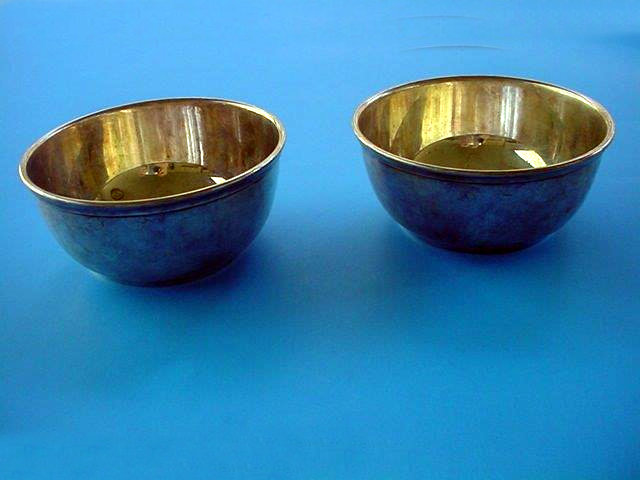
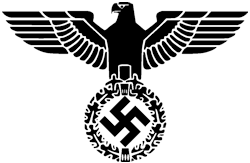
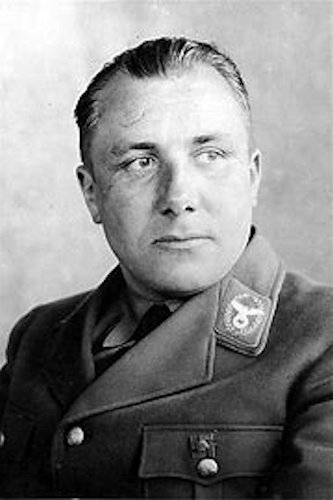
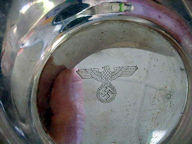
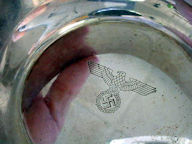
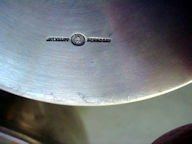
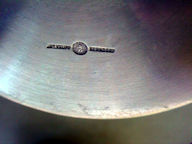
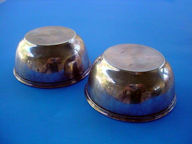
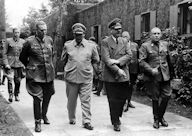
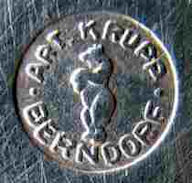
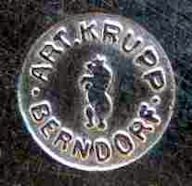
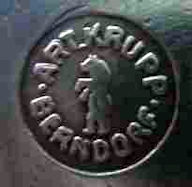

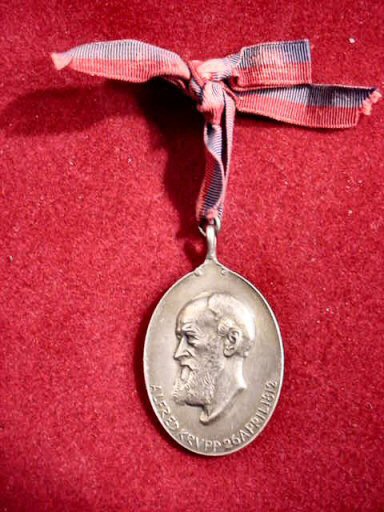
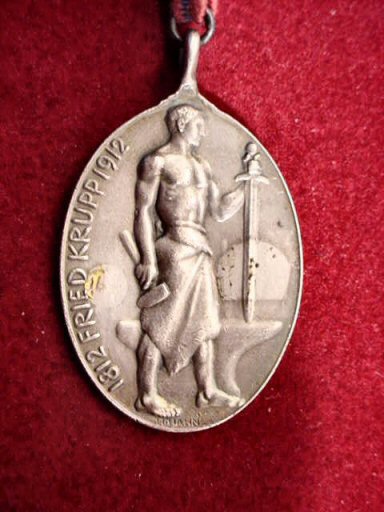
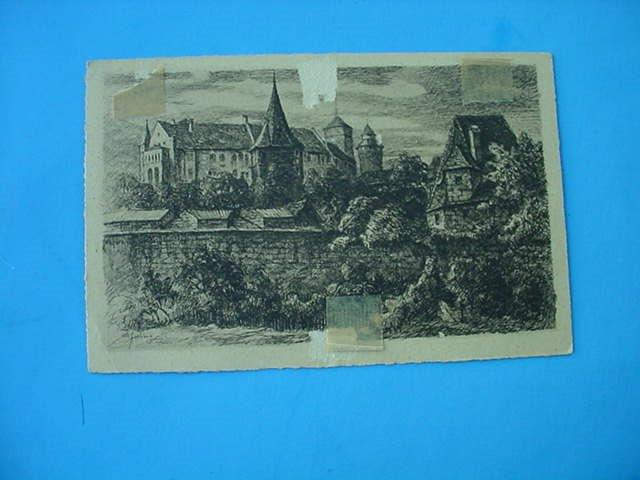
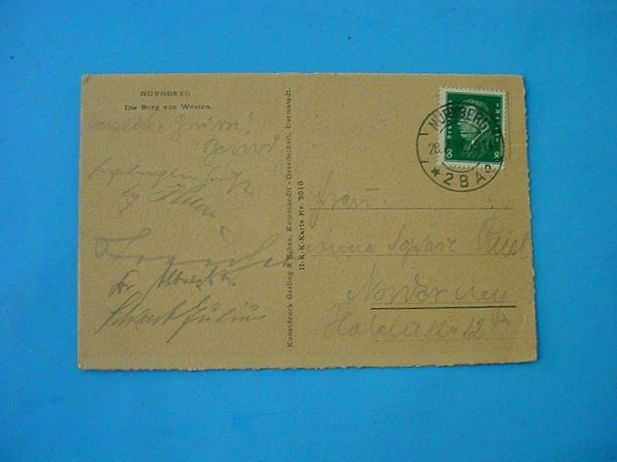
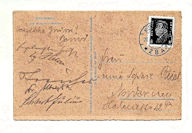
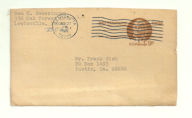
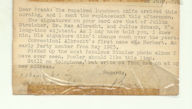
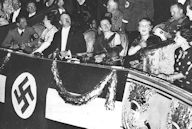
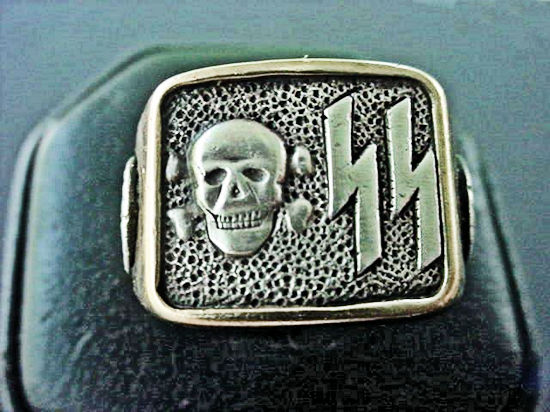
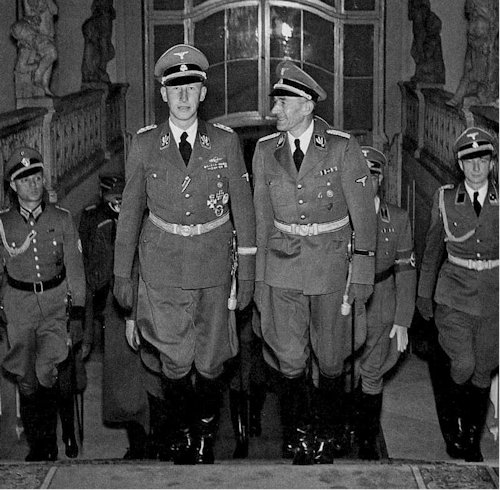
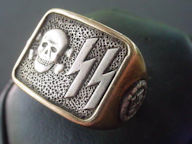
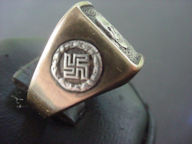
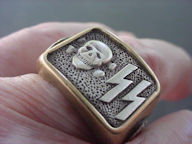
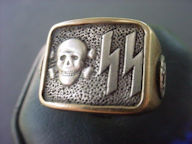
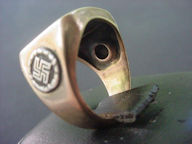
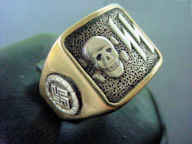
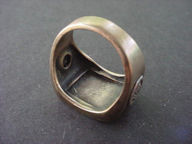
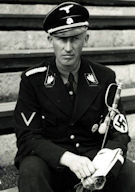
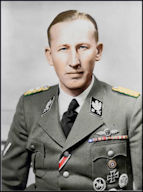
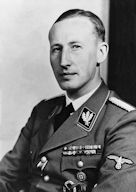
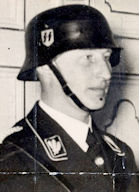
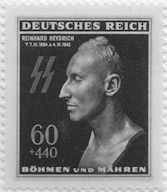

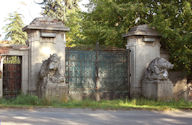
 Ring Having Been in the Possession of Obergruppenf�hrer Reinhard Heydrich (Item PERS 7-8; SS 38-32; SPECIAL SALE)
Ring Having Been in the Possession of Obergruppenf�hrer Reinhard Heydrich (Item PERS 7-8; SS 38-32; SPECIAL SALE)